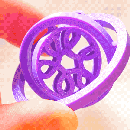Introduction: How to SAFELY View the Sun to See a Solar Eclipse and Search for Sunspots.
I am going to show you how to view the sun using several indirect viewing methods, ranging from looking at shadows on the ground, to projecting through a telescope. I have recorded a video that explains how solar projection works, and provides several different examples of how to project the sun.
It is easy to think the best way to look at the sun is through glasses with special lenses, but it isn't, for several important reasons.
- Some "eclipse glasses" are not actually safe for solar viewing - some of the ones I purchased online were just recalled by Amazon.
- The filter discolors the sun, giving it an orange color - it actually looks white.
- I think we assume the image is better because we are looking directly at the sun, but the image is really small. You can achieve bigger and clearer images through indirect viewing methods.
The materials you will need for this method are as follows:
- A thumbtack
- Cardstock
- Cardboard
- A tree
- A cheap refractor telescope. Here are a few that work:
- Telescope I used - $30 telescope
- a cheaper one: $11 telescope
- another cheaper one: $27 telescope
- a slightly more expensive one: $38 telescope
Step 1: Pinhole Projection
All you need to view the sun is a small pinhole, that you can poke into an index card or a piece of card stock. Punch a hole in the card, and hold up in the air. Catch its shadow on another card. The light spot you see in the middle of the card is an image of the sun. You are seeing an actual projection of the sun. It is similar to how when you look at a projector bulb it appears very bright, but you can see an image when you see it land on a screen. The same thing is happening here. You may notice that the eclipse appears to be rotated 180 degrees. This is an effect that occurs when the light traveling from the sun passes through a pinhole.
Step 2: Pinhole Projection (using a Box)
You can get a slightly clearer projection using a cardboard box. If there are holes in the corners or sides, cover them with tape. Then, punch a hole in the box, and point the side with the hole towards the sun. Look for the light that appears on the far side. This is the image of the sun on the back of the box.
Attachments
Step 3: Pinhole Projection (using a Tree)
You don't actually need anything to view the sun or look at an eclipse. Tiny gaps between leaves in trees act as pinholes, and so you can see the sun any time you look at the shadow of a tree on the ground. When an eclipse happens, the tiny dots turn into tiny crescents.
Attachments
Step 4: Telescope Projection
The best way to get a really clear image of the sun is to project it using a telescope. (Never look at the sun directly with a telescope). This only works with cheap telescopes, more expensive telescopes can be damaged if pointed directly at the sun. But with the right one, you can point the telescope straight at the sun, and catch its projection on a piece of cardboard or foam board. The key to aiming the telescope at the sun is to make its shadow on the ground as small as possible. The image is very clear, and you can get it to about 16" in diameter. It is big enough that you can actually see sunspots on the surface of the sun, and should be a pretty incredible way to view a solar eclipse.

Participated in the
Outside Contest 2017














